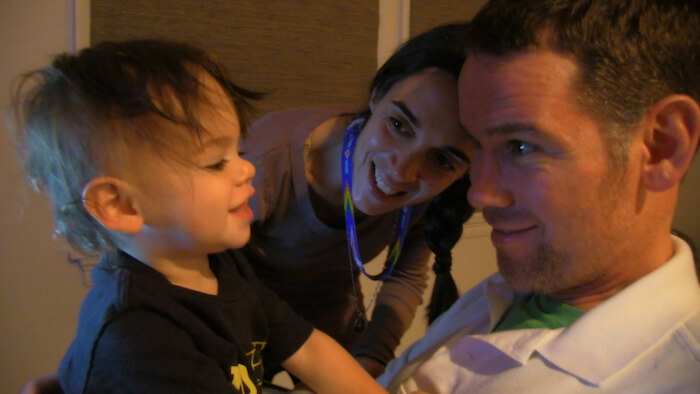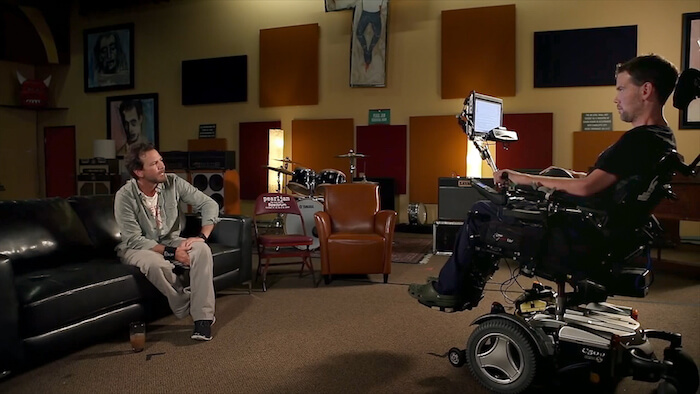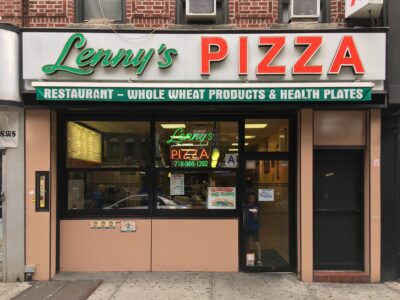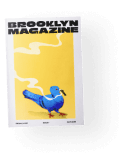“Everyone thinks it’s going to be this story of heroism, about football and ALS”: Talking to Gleason Director Clay Tweel
 It’s rare that footage finds a documentary filmmaker rather than the other way around, but that’s exactly how Gleason, the latest from Finders Keepers helmer Clay Tweel, came to be. Following the triumphs and tragedies of ex-NFL hero Steve Gleason as he battles the debilitating effects of ALS, this heart-and-gut-wrenching film is so affecting precisely because it’s narrated by Gleason himself. The former star defensive back for the New Orleans Saints began filming a video journal shortly before he was diagnosed with the disease and given only a few years to live, but when his wife Michel discovered she was pregnant, the project was kicked into high gear. Determined to preserve as much of himself as possible for the sake of his unborn son, Gleason enlisted cameramen David Lee and Ty Minton-Small to film the sometimes painfully candid, sometimes endearingly humorous moments that make up his and Michel’s—and eventually, their son Rivers’s—daily lives. By the time Tweel signed onto the project there was some 1300-odd hours of material from which he had to extrapolate a story in a record amount of time.
It’s rare that footage finds a documentary filmmaker rather than the other way around, but that’s exactly how Gleason, the latest from Finders Keepers helmer Clay Tweel, came to be. Following the triumphs and tragedies of ex-NFL hero Steve Gleason as he battles the debilitating effects of ALS, this heart-and-gut-wrenching film is so affecting precisely because it’s narrated by Gleason himself. The former star defensive back for the New Orleans Saints began filming a video journal shortly before he was diagnosed with the disease and given only a few years to live, but when his wife Michel discovered she was pregnant, the project was kicked into high gear. Determined to preserve as much of himself as possible for the sake of his unborn son, Gleason enlisted cameramen David Lee and Ty Minton-Small to film the sometimes painfully candid, sometimes endearingly humorous moments that make up his and Michel’s—and eventually, their son Rivers’s—daily lives. By the time Tweel signed onto the project there was some 1300-odd hours of material from which he had to extrapolate a story in a record amount of time.
“There was no time to sit back and ruminate,” Tweel told Brooklyn Magazine in a recent phone interview about the film, which opens July 29. “You just had to be decisive and go. Creatively, I think in a weird way that was a benefit. Watching the footage just going: “’OK, what are the best moments? Let’s sequence those best moments and figure out what that story is.’”
Unfolding in bursts of unstoppable emotion, there are innumerable moments in the movie sure to reduce even the toughest viewer to a puddle of tears. There’s the scene in which Michel notices the first hint of a limp in her strapping husband’s gait and can’t stop herself from crying as the reality of his illness washes over her; or the time we get to witness the pure joy on Steve’s face when his son calls him “dada” for the first time (by this point he’s already restricted to a wheelchair). Then there are the clips where Steve, rapidly losing his ability to speak, confronts his born-again Christian father about their own, historically tenuous relationship. The cumulative effect is both inspiring and utterly devastating and Tweel manages to draw out a complexity of emotion that extends far beyond the film’s wounded-warrior logline. Gleason is as much about the practical realities of living with ALS—enemas, electronic voice machines, and endless exhaustion—as is it about facing the looming existential questions that come with it—birth, love, and most dauntingly, death.
“It’s not how we act when things are great, but how do we act when things are difficult?” the minister who marries the handsome couple asks rhetorically during what appears to be a breezy, low-key ceremony. It’s a question that echoes throughout the movie, one that not only commands compassion in the viewer, but also (quite unexpectedly) demands unprecedented levels of introspection. This is a film that will wring you out even as it lifts you up.
Your previous projects like Finders Keepers and Print the Legend, which I’m a big fan of, might be characterized as niche films. Gleason seems to have really broken into the mainstream—or at least seems positioned to do so. Did you have a sense when you saw the footage that this was going to have such a broad reach?
I think that there’s an aspect of that, yeah, just because of the football. That was something to consider when doing the film. You hope and you dream that people are going to watch the movie but I don’t think I was ever like “Oh, this is going to be the big one!” I do think that the goal in all my work is trying to tell a story that’s going to in some way subvert the expectation of the audience a little bit. For Print the Legend, which everybody thought was going to be about 3-D printing, we don’t talk about 3-D printing until like ten or fifteen minutes into the movie. And in Finders Keepers, we quickly move past the jokey logline after about twenty minutes as well, and we really start to peel back the layers of who these characters are. For Gleason, it’s somewhat similar in that everyone thinks it’s going to be this story of heroism, about football and ALS. But we really tried to make it a story about something that goes much deeper, touching on themes of fathers and sons, testing the boundaries of love between a husband and wife. So that’s kind of what I like to do, subvert expectations a little bit.


The father-son stuff between Steve and his dad was actually the thing that hit me the hardest. I know you were sifting through something like 1300 hours of footage—was that thread evident as something that was going to be prominent from the get-go or did it come later in the process?
I think it was through a process of watching the footage and some of the early talks I had with Steve and Michel. When I first started I thought the movie was going to be about this guy who finds his purpose in life through a set of tragic circumstances—through being diagnosed with ALS—and then he kind of dedicates himself to Team Gleason and his son. What I didn’t understand was that the whole concept of the movie—some guy trying to pass on who he is to his unborn child—is actually a direct reflection of his own relationship with his father. So that inter-generational story of fatherhood emerged as I started to see footage of how he and his dad interacted with each other and some of the conflicts they had, and how truly that seemed to be resolving by the end of filming. It was kind of amazing to see how they were able to have incredibly open and honest conversations about how they’re feeling. And I think that really yielded a very powerful thread to tie the movie together.
For sure: that scene when Steve tries to run at the faith healer was one of the most painful to watch in the entire movie.
Yeah, I went down to New Orleans and that was the first thing he showed me. He was just like, hey, check this out, and he pulled it out on his tablet. My jaw hit the floor, and I was like “Well… that’s pretty interesting, Steve.” And the footage that I started watching just got more powerful from there.
You’ve spoken in other interviews about how this was a bit of an unusual process for a documentary in that the subjects found you rather than the other way around. How did the material actually wind up in your lap and what was the starting point? It sounds like an incredibly daunting amount of footage.
Yeah, it was certainly daunting. I was sent a little teaser trailer clip that had been put together over the course of the three and a half years they had already been filming and I think that what that piece did and showed me immediately was that it was both heartwarming and heart-wrenching at the same time. Those complexities and juxtaposing emotions were really fascinating and impactful to me. And I had heard Steve’s story… I remember watching the punt block game live. I’m a pretty avid sports fan so I remember watching that and the moment when he came back and led the “Who Dat” chant in the game against Texas, I was watching that live too. So I had an idea of who Steve was, but really it was being able to understand how impactful Steve was watching that clip. A little bit of a personal connection for me—my dad has been Mohammad Ali’s lawyer for the last 30 years, and seeing a sports hero and his loved ones go through a debilitating illness and what that does, I felt like I had a unique window to try and tell Steve and Michel’s story. [There was] a massive about of footage to try and carve a narrative out of, yeah, but that was the task and we just kind of hunkered down to see what the footage would reveal to us as the best story.
What was the collaboration like with the filmmakers who actually shot the footage and with Steve and Michel? Was there anything, for example, that was too personal that they preferred you to leave out or did you have final cut of the movie?
I will say it was a family affair. It was a joint effort in that the guys who film most of the footage, Ty Minton-Small and David Lee, came on and helped us edit. They moved to LA and really helped out—I couldn’t have done it without them because they lived it and breathed it and were able to help prioritize and really made the process a lot more efficient. On top of that I had an [ongoing] dialogue with Steve and Michel. I think one thing I try to do in all of my films, is that I try not to be exploitative. I’m always trying to find that line. Finders Keepers is a very fine line because we want to do justice to who those characters are—they’re very funny guys, and self-aware. For [Gleason], the exploitation factor is not taking advantage of how vulnerable and raw and honest Steve and Michel are, so I wanted to always be collaborating with them. I showed them multiple cuts of the film and make sure none of this was going to make them uncomfortable, or have the film be something that they wouldn’t want to have out in the public space, while also accomplishing the goal of communicating the daily realities of living with ALS.
One of the things I really loved is the well-rounded focus on Michel’s experience as caretaker. Rather than simply lionizing her, the film really doesn’t hesitate to show all sides of what Steve’s illness means for her—the frustration and exhaustion that comes along with her ever-increasing responsibilities. That scene when Steve is lying in bed trying to talk to her, asking what he can do better to make things easier/better for her. That was another scene that hit especially hard.
That scene has hit a lot of people super hard and has come up a lot in interviews. I think that it’s moving because you get a window into the complexity of emotion that Michel is going through: she is feeling resentment, and then shame and guilt for feeling that resentment, and is exhausted for feeling all of these all at once, and is just emotionally spent. Those layers of emotions are kind of breaking her down, so you see this disease as breaking Steve down physically and breaking Michel down emotionally. There’s just so many layers in that scene: it’s a powerful one because it says so much of her experience.


There are a lot of humorous moments as well which adds some much needed levity. When the nurse comes to give Steve an enema, for one.
[Laughs] Yeah.
Or that moment when his dad asks how is his tastes buds are holding up [which is something that’s not at all affected by ALS]. It’s painful to see how little he understands about Steve’s experience, but Steve and Michel find his ignorance totally hysterical. How did you manage to find a balance in tone?
That’s certainly one of the bigger challenges here. We were guarding against what our producer called empathy exhaustion. We didn’t want our audience to feel emotionally assaulted, or cried out an hour into the movie. And if you spend any time around Steve and Michel, to this day, you can tell that they are just fun-loving, spirited people. Steve still has the ability to light up a room just by smiling, so I think that we wanted to also show the way they confront the challenges of this disease is in a very lighthearted way. That allowed us to offset some of these sad moments. That balance of humor mixed with sadness is something that was certainly necessary to be able to take the audience on the roller coaster of emotions that kind of mimics Steve and Michel’s experience.
On a technical level, was it challenge to edit all this footage given it was shot on non-professional cameras?
It was a wide variety of cameras—like 400 different cameras. I was an idiot and decided to try out a brand new editing system as well for this movie. I was using Adobe Premiere for the first time, so that was certainly a challenge to try to figure out the technical side of everything as well as dealing with an amount of footage that was as much as my three other movies combined. It was an experience, and I learned a lot.
On an emotional side in the editing room, we were watching other movies for kind of tonal references before we started. We’d watch like Dear Zachary, or some of Laura Poitras’s films because they’re great examples of vérité-type editing techniques, and we obviously watched Michael Keaton’s My Life, there’s a connection [to our film] in the plot there. But when we got in the thick of it, we balanced ourselves out emotionally by watching comedies everyday at lunch [laughs]. We watched a lot of Nathan For You and Eastbound & Down, which is one of Steve’s favorite shows—they often made references to it in the footage, so we were keeping up with their humor by watching Eastbound.
I read that the whole process of getting this film made was five years—how long did you actually have to work with the footage?
Steve started [filming] right when he was diagnosed, in 2011, and I came on in early 2014. But we didn’t really start editing until March of 2015. So I didn’t have the footage in my hands to start working on it until then. It was a very, very quick post schedule and we essentially had to watch and edit the movie in about seven and a half/eight months in order to try and submit it to Sundance, which, for this amount of footage is crazy. But I think the benefit of that was that there was no time to sit back and ruminate. You just had to be decisive and go! Creatively I think in a weird that way that was a benefit. Watching the footage just going: “OK, what are the best moments? Let’s sequence those best moments and figure out what that story is.” It was an intense process for sure, but being able to step back now, I feel like that actually helped.
You might also like 



















